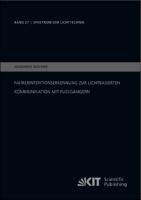Fahrerintentionserkennung zur lichtbasierten Kommunikation mit Fußgängern
Dissertations in Series (Dissertationen in Schriftenreihe)
| dc.contributor.author | Reschke, Johannes | |
| dc.date.accessioned | 2022-10-10T12:51:36Z | |
| dc.date.available | 2022-10-10T12:51:36Z | |
| dc.date.issued | 2022 | |
| dc.identifier.uri | https://library.oapen.org/handle/20.500.12657/58529 | |
| dc.description.abstract | Especially pedestrians rely on the interaction with other road users. The introduction of automated driving systems withdraws this communication from drivers and thus, vehicles need to interact with pedestrians. Therefore, multiple vehicle-pedestrian-communication concepts are evaluated. A driver intention prediction allows pedestrians to learn these newly introduced signals, while driver and vehicle communicate simultaneously. | en_US |
| dc.language | German | en_US |
| dc.relation.ispartofseries | Spektrum der Lichttechnik | en_US |
| dc.subject.classification | thema EDItEUR::T Technology, Engineering, Agriculture, Industrial processes::TH Energy technology and engineering::THR Electrical engineering | en_US |
| dc.subject.other | Fahrzeug-Fußgänger-Kommunikation; Symbole; Farben; Neuronale Netze; Automatisiertes Fahren; Vehicle-Pedestrian-Communication; Symbols; Colors; Neural Networks; Automated Driving | en_US |
| dc.title | Fahrerintentionserkennung zur lichtbasierten Kommunikation mit Fußgängern | en_US |
| dc.type | book | |
| oapen.identifier.doi | 10.5445/KSP/1000145569 | en_US |
| oapen.relation.isPublishedBy | 44e29711-8d53-496b-85cc-3d10c9469be9 | en_US |
| oapen.collection | AG Universitätsverlage | |
| oapen.series.number | 27 | en_US |
| oapen.pages | 266 | en_US |
| peerreview.anonymity | All identities known | |
| peerreview.id | 51a542ec-eaeb-47c2-861d-6022e981a97a | |
| peerreview.open.review | No | |
| peerreview.publish.responsibility | Books or series editor | |
| peerreview.review.stage | Pre-publication | |
| peerreview.review.type | Full text | |
| peerreview.reviewer.type | Editorial board member | |
| peerreview.reviewer.type | External peer reviewer | |
| peerreview.title | Dissertations in Series (Dissertationen in Schriftenreihe) |

